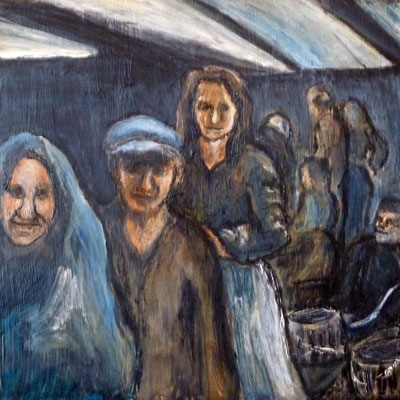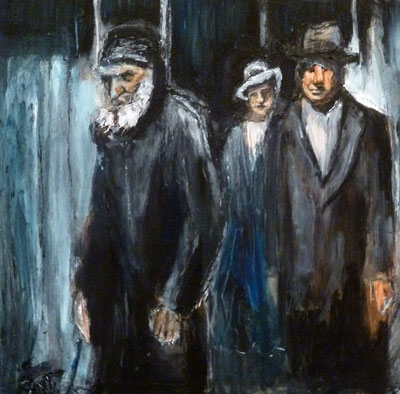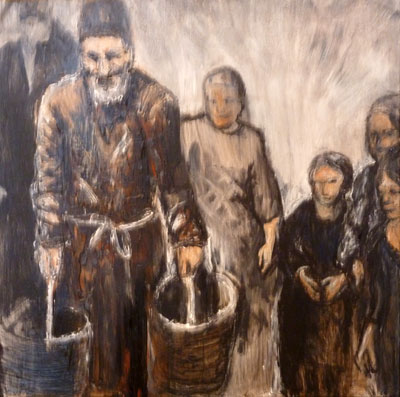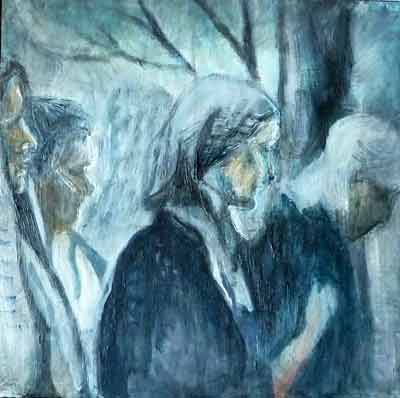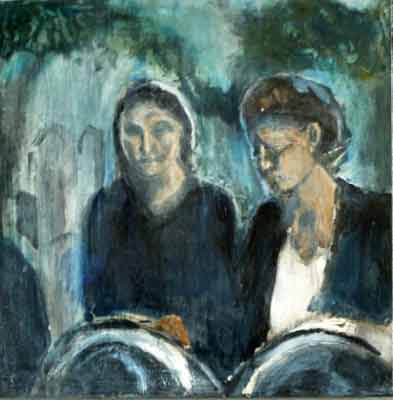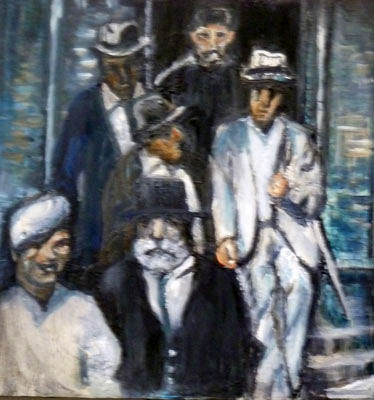|
Archives
Ordering
Material from the Radom
Archives
Susan Weinberg shares her
experiences ordering materials from
the Radom Archives spanning birth,
death and marriage records, Books of
Residents pages and identity
papers. She also discusses the
contents of the original Books of
Residents pages and the on-line
archive resources.
I - Travel to
Radom: Using the Radom
Archives
A private
researcher relates his
experience using the Radom
Archives while visiting Radom
and successfully identifying
information despite no Polish
language skills.
Susan Weinberg
relates her recent experience in
using the Radom Archives, the
types of information she located
and descriptions of information
on the Jewish community of Radom
which she found and has provided
on this site. She also
relates her experience getting
records from the past 100 years
at the USC.
Radom Archive
Information on the Radom
Archives: includes contact and access
information..
Use Google Translate to
translate
from Polish.
The Head
Office of the State
Archives
The State
Archives used to have several
entry points for different
types of records, but in
2018 consolidated
it into
www.szukajwarchiwach.pl or
in English
searcharchives.pl. From
there you can click on Vital Records and Civil
Registers over the
search box to identify what
civil records are held
at the archives. Enter
the town and
then look for the word mojżeszowe
(Jewish) to identify
Jewish records. Note
the accent over the Z.
If you are searching,
copy
and paste in
the word with the
accent.
If
you had family
in Radom during the
Holocaust, you may
want to check here
to see if there
is an identity
paper from
1941. Often this
is the only way
to find a
photograph of an
ancestor.
Routes to Roots
Foundation
A search for Radom will surface
documents held in the
Archives. While not as
current as the State Archive
database, it is in English and
offers a good starting
point. A search for
postcards and photos can also be
done from this site.
Jewish
Historical Institute Genealogy
Assistance
If you are in
Warsaw stop by the
office located across from the
Jewish Historical
Institute. From there or
via e-mail they can assist you
with a variety of materials on
Radom. Such materials
include lists of property
owners, old Radom phonebooks and
photographs. Contact Anna
Przybyszewska Drozd at familyheritage@jhi.pl.
Radom
Library
The
Radom Library offers digital
access and a number of its
documents come from the Radom
Archives. There are several
documents there that will help
you identify addresses at
which family may have
lived. One is called Nowy
Informator and lists
property owners from 1902. You will find
the addresses and names
with many Jewish names
among them. Please
note: the Safari browser
does not work to access
links to the library, but
Chrome does.
Another source is
the telephone book.
There are several that are
available digitally from
the library. Start
with the 1935
Appendix which
is still a Polish version.
You will find Radom if you
input screen 7 (not the
page number) and there are
many Jewish names. Then
move onto the 1940
Telephone Book
which is now
in German where you will
still find Jewish names.
Note that the German
directories include
Krakow, Lublin,
Radom and
Warsaw. Radom
begins on screen 122. In
the 1942
Telephone Book you can find
Radom beginning on screen
55. It
is followed by the small
towns that surrounded
it. While listings from
this period would be
mostly Poles and many Jews
had already been deported,
it may
identify businesses
from during the war.
Another
source of addresses is the
Informator
1933-34 which
lists residents by
profession.
And for those
who speak Polish you can
find many
Polish newspapers at the
library, some from the war
years and earlier.
ORDERING
FROM THE RADOM ARCHIVES
by
Susan Weinberg
The first time you place an
order with the archives it can
feel a bit intimidating, but the
results can be well worth the
effort. Jewish Records Indexing
- Poland (JRI-Poland)
provides useful instructions
for general ordering from
archives. The following
instructions are provided based
on specific experience with the
Radom Archives.
First you will need to determine
what you want to order and how
to communicate that to the
archives. You will also
want to determine at which
archive it is held. The
following information relates to
the Polish State Archive in
Radom which holds material that
is over 100 years old.
There is also the civil
registration office (USC)
which holds more recent
materials. My experience has
encompassed ordering birth,
marriage and death records
(B-M-D) as well as the original
pages of Books of Residents and
identity papers. The
JRI-Poland Database will provide
information on both B-M-D
records and Books of Residents.
B-M-D records identify the name,
year, type of record and Akt.
You will also find the fond
number at the top of the
section. Books of
Residents identify the name,
fond, signature and card number
as well as descriptive
information. You will want to
provide this information to the
archives in order to obtain
these materials.
While the Book of Residents data
in JRI-Poland is helpful, the
actual pages provide additional
information typically in the
notes ("uwagi") column..
The records in the JRI-Poland
search results only contain data
on individuals born at least 100
years ago, whereas the actual
records will include all members
of the family. Check JRI-Radom
Indexing to see if what you are
seeking has been
indexed. .
Each Book of Residents record
spans two pages, generally in
Russian depending upon the
period reported. To see
the type of data contained,
click on each side of the image
below. On the left side
the men are listed in the first
column, women in the
second. The page starts
with my great-grandfather Meyer
Wajnberg. Following the
first row across you will see
his parents names, Sima Wajnberg
and Malka Rozenberg, in the
third column. Following this is
his birthdate and Sienno, his
place of birth. Now click
on the right side where you will
see a record from Sienno which
is referenced by number in the
second column. The last
column is where you will see
that he died in Radom in 1928 at
the age of 75. You can see
that there are additional
entries in faded ink which I
have been unable to decipher.
The second record is for my
great-grandmother, Szajndla,
daughter of Josek Rubinsztajn
and Laia Bekierman and reveals
that she died in 1920 at the age
of 70. On another page I learned
that her mother Laia lived with
her youngest son until her death
at age 92, a lengthy lifespan
for someone born in 1812.
The fifth entry in the far right
column reports on the marriage
between my great-aunt Bajla and
Szmul Cukier and the final entry
in the last column is for my
grandfather shortly before he
immigrated. My hunch is
that it reports on his
emigration plans. The
information in this column can
only be accessed from the
original pages.
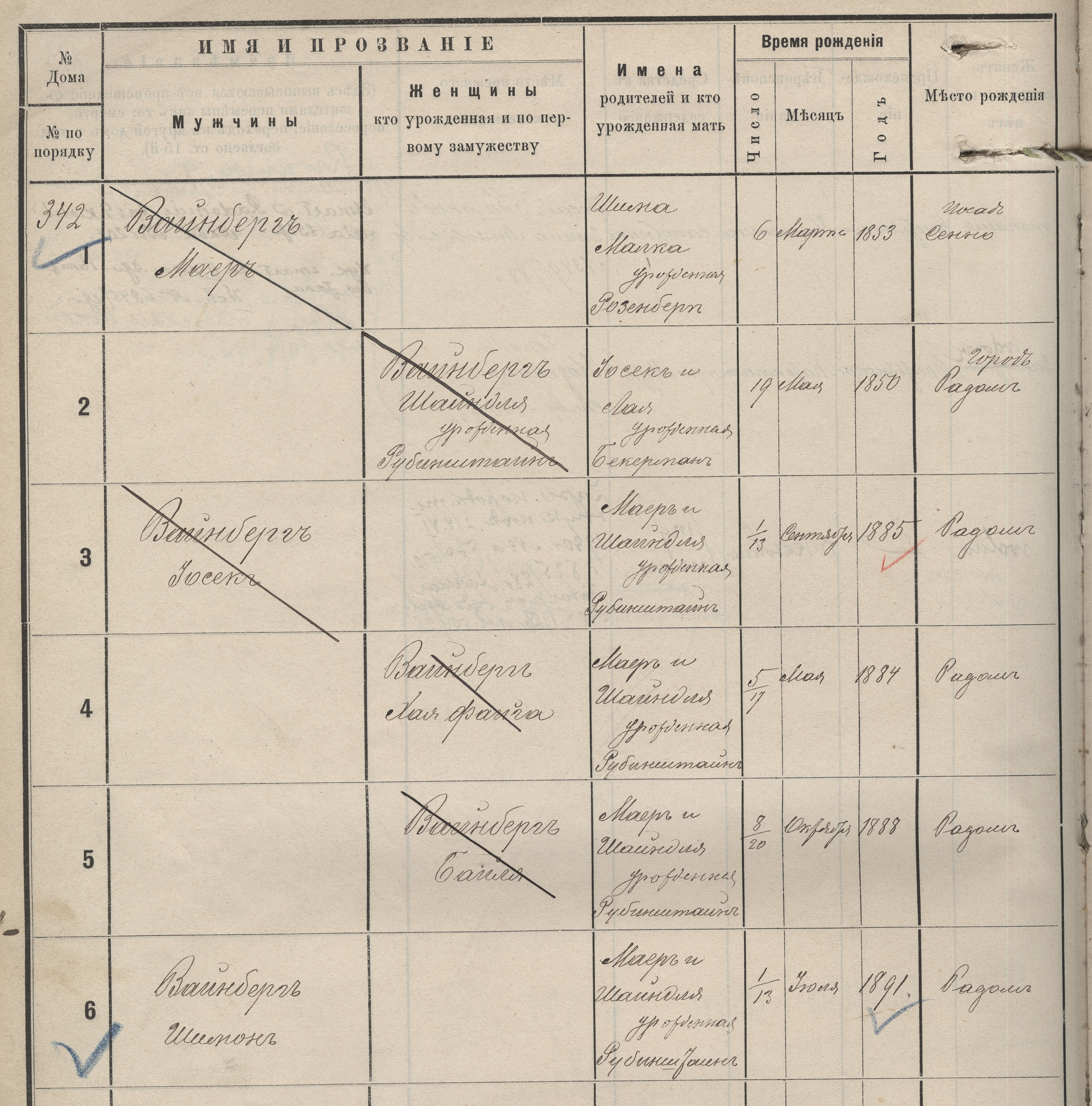 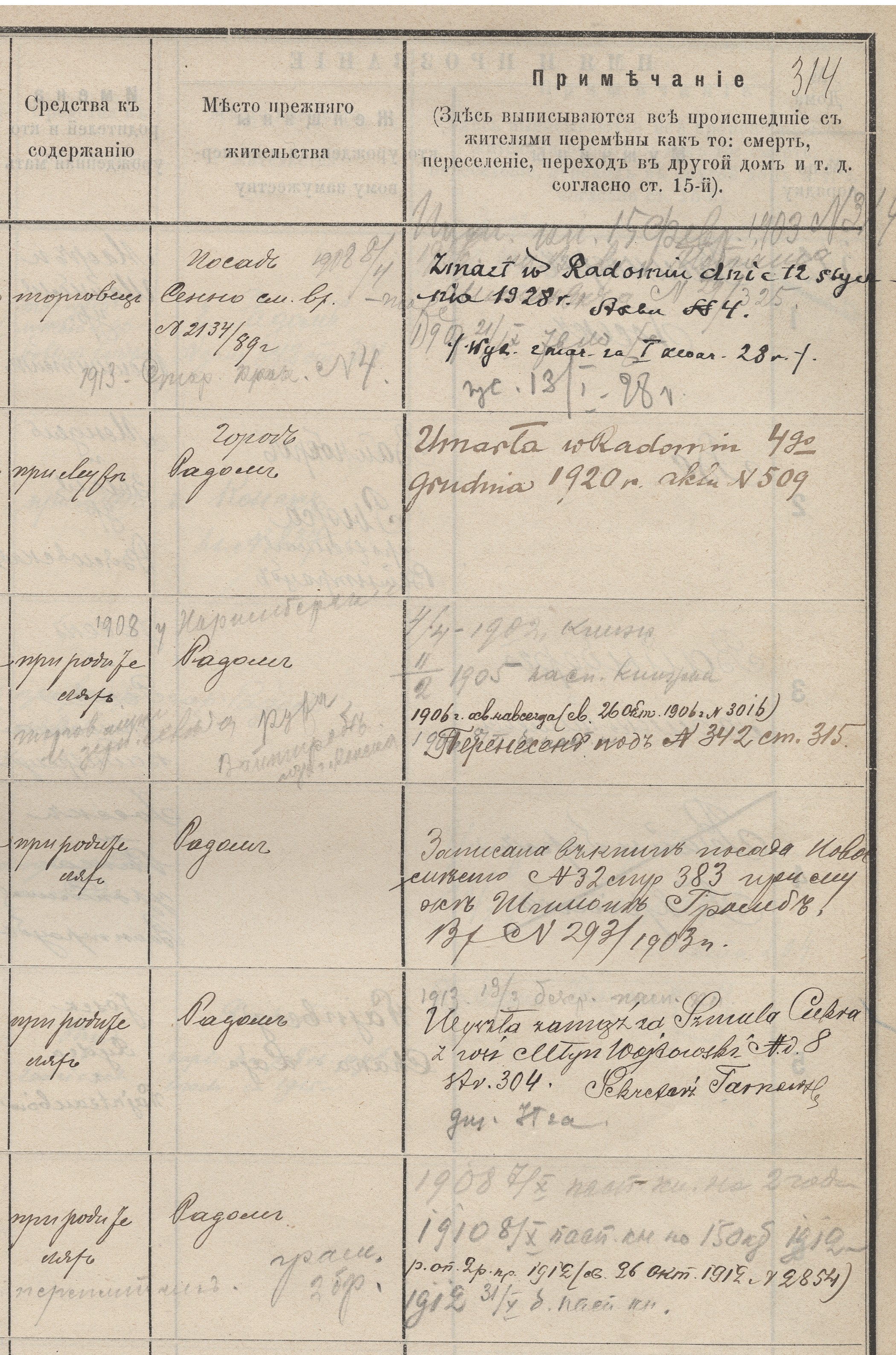
Sample Book of Residents Page
- click on each side to
enlarge
In addition to the material
which you can identify through
JRI-Poland, the archives also
hold identity papers. You
can find examples of these on
the Pictures page. These
date back to 1941 when Jews were
required to complete an
identification form, a rather
sad document as we now know it
was a year prior to their
murders. I provided a list
of names to the archives for
which they requested
birthdates. I received
about 10% of what I
requested. The records
provide parents' names,
birthdate and address and often
the only photograph that we can
access for our family members. These records are
housed under
Naczelna Rada Starszych
Ludności Żydowskiej
Dystryktu Radomskiego w
Radomiu. Dział Dowodw
Osobistych which translates
to "Supreme Council of
Elders of the Jewish
population of the District of
Radom in Radom. Department ID
Cards "
In addition to these records,
you can pursue other records
identified at the The
Head Office of the State
Archives website.
While the databases are in
Polish, you can identify Jewish
records by searching for a few
key words; Mojzeszowe,
Starozakonnych and Zydow all are
words which mean "Jew".
You may find such gems as a file
titled, "wykaz starozakonnych,
ktrzy przybrali nowe nazwiska"
which roughly translates to
"list of Orthodox Jews with new
names". The date is
1822-23 which is when Jews had
to take last name (reference
number 459).
Once you identify what you want
to order you will want to place
your order by e-mail. The
e-mail I have used most recently
is
poszukiwania@radom.ap.gov.pl,
but check the Radom
Archive site to assure
that this is current. I request
a CD in TIFF format at 600dpi
and the quality that I've
received has been
excellent.While you can write in
English, the response will be in
Polish. Their communication may
be to ask for more information
or to inform you that some of
the requested information is
held at the civil registration
office. If they can work
with what you provided you will
receive wire instructions from
them and the amount of the order
in zlotys. They will give you
the equivalent amount in dollars
and you can send the amount in
zlotys or their dollar
equivalent. There will
typically be a charge at your
bank for an international wire
in addition to the order itself.
I have encountered delays in my
orders which have usually taken
at least 6 weeks to arrive.
Return to
Archives
MY
TRIP TO RADOM:Using the
Archives I
Pictures none
of us ever saw, of
people none of us ever
met
Courtesy of
private submitter
In
April 2009, my travels took
me to Poland where I visited
concentration camps, the
shtetls where my ancestors
used to live and the
archives in which their
records are housed. Two of
my grandparents were brought
up in Radom, one of them was
born there and the other in
a small village nearby.
As
in other Polish towns, there
are two relevant archives :
the PSA and USC. The PSA
(Polish state archive) holds
mainly information that is
older than 100 years. It
holds this information from
Radom itself and from other
smaller towns and villages
around. In addition there is
some Holocaust related
material there.
The
USC (Urząd
Stanu Cywilnego - civil
registration office) holds
all the records that are
less than 100 years old from
Radom only. The Polish law
states that papers less than
100 years old are to remain
classified. Any access to
them requires proof of
relation to the people in
the document.
If driving in Poland it is
recommended to use a
GPS. Below are GPS
instructions for the two
archives:
| Archive
type |
Town |
Area |
GPS
north |
GPS
east |
Address |
| USC |
Radom |
Radom |
51.3984168 |
21.1539335 |
5
Sniekiewicza Henryka |
| PSA |
Radom |
Radom |
51.4032881 |
21.1432414 |
1
Rynek
|
I actually went to the Radom
PSA 3 times on different
days of that trip, each time
with additional information
looking for additional
records. There were two very
nice archive employees there
that went out of their way
to help out when they
realized I am a Jew with
Radom ancestors. While their
English was far from
perfect, by working with
both of them simultaneously
we managed to understand
each other.
They
helped
me find a few records that
were not yet indexed by
JRI-Poland but over a 100
years old (from 1907-1908).
Than they brought me a book
containing the indexes of
Jewish ghetto IDs. There I was
able to find long lost faces,
pictures of my
great-grandparents, my great
uncles and aunts, and of my
father's cousins. Pictures
none of us ever saw, of people
none of us ever met. The IDs
also contained additional
information including birth
date, birth place, family
information and even about
their place of residence in
the Ghetto. I found a lot of
precious details there, things
I could never have found
otherwise.
The
USC is a far more strict
archive. There you need to
prove your relation to people
in order to receive any
information. I found a young
woman there who speaks English
fluently and was very happy to
help under the conditions of
the Polish law. I came there
with a notary letter clearly
stating the names of my
ancestors as others warned me
that I would get nothing
without it. They showed very
little interest in that letter
and it took some convincing
(and begging) before I could
get the information.
After
leaving them detailed
information about my family
(even though I now know it was
partly inaccurate), I was told
to leave and come back 2 days
later. When
I came back I had a big
surprise - they found dozens
of BMD (Birth, Marriage and
Death) records about my
family. These gave me many
details I knew
nothing of.
The
old Jewish center of Radom is
today being destroyed and
rebuilt. The roundabout in
Walowa St. (Ulica Walowa), for
example, is the center of
a large construction area
nowadays. It was the center of
the Jewish area 70 years ago.
The old area is changing, but
along with it evidence of the
way our ancestors lived is
also about to vanish.
Visiting
and
taking pictures of a house my
family once lived in, I
noticed the owner of the house
looking at me nervously from
the house. As I was leaving
the place, the local police
arrived and went in there. I
believe he called them because
I was taking pictures of the
house. Naturally I didn't
stick around to find out. The
locals are probably afraid of
Jews claiming the houses once
owned by their ancestors.
Return
to Archives
MY
TRIP TO RADOM:Using the
Archives
II
Courtesy of Susan
Weinberg
On a visit to Radom in
2011, I spent several days at
the Archives (PSA) and found
much information on both my
family and the broader Jewish
community. The Archives
were located at 1 Rynek facing a
small square, but when I
returned in 2018 had moved to
Stanislawa Wernera 7.
It is typical of most archives.
When you enter you will find
lockers where you should deposit
purses, briefcases and
jackets. You can take a
computer into the room.
Pencils are available at the
front desk as they do not want
you working with pen.
Originally you could not take
photographs, but could purchase
copies for 3 zlotys or scans for
6 zlotys. On a later visit in
2018, they did not object to
photos. The people who
work there are very helpful and
understand some limited
English. Much has changed
since that 2011 visit as they
are working to get records
on-line. You will find
many of the key Radom on-line
records in the Names Tab in this
Kehilalink.
Prior to going to the Archives I
did extensive preparation by
searching within the Polish
Archives on-line catalog (Note:
much has changed by 2021 in the
organizational structure of the
archives documents, often making
it challenging to locate prior
records today) This required the
use of translation software as
the catalog is in Polish.
The Archives do not have
Internet access available for
patrons so it was fortunate that
I printed out the information on
which I wished to search.
You will want to record the fond
and identifying information from
the desired record and they can
then locate it for you.
While the Book of Residents is
available on JRI-Poland it
includes information that spans
the period from 1860-1930.
Even though it covers periods up
to 1930, JRI-Poland cannot put
information out that is from the
last hundred years due to
privacy issues. Later
records can be found at the USC
where later civil records are
located. They will
want you to verify your
relationship before providing
the information although they
seemed to accept my provision of
family trees as adequate proof
of relationship. One of your
first approaches should be to
search what is available on
JRI-Poland so you can easily
locate the original Book of
Residents records for family
members. Record the identifying
numbers to assist you in
locating family members.
By ordering original Book of
Residents pages, I had found the
death dates for my
great-grandparents and went to
the USC to obtain their death
certificates as well as another
family member's marriage
record. The USC does not
give you a copy of the
record. Rather they
complete a form with the
relevant information which for
marriage records included age at
marriage, parents' names and
date of marriage. The USC
is not really an archive so most
of the people who frequent it
are seeking copies of current
records. As a result the
costs are higher so you may wish
to use it judiciously. A
record costs 22 zlotys which is
roughly $7 at this writing
(2011). I had e-mailed the
USC at usc@umradom.pl ahead of
time to determine which of my
records they had available and
received a response in
English. I then asked for
the person who I had
corresponded with when I went to
the USC which simplified the
process
considerably.
Back at the PSA Archives (which
holds records older than 100
years), I requested access to
the Book of Residents from 1840
which is the earliest Book of
Residents that is
available. They provided
me with a handwritten index by
surname. Within each
surname is listed the given
names in each family
grouping. I had previously
found the records for my
great-grandparents and their
children in the Book of
Residents through
JRI-Poland. By going back
to the earlier 1840 records, I
found the page with my
great-great grandparents and
their children, several of whom
I had been unaware.
In the course of my research I
had found a record titled wykaz
starozakonnych, ktrzy
przybrali nowe nazwiska.
If you've worked your way
through Polish birth, marriage
and death records you know that
the word starozakonnych
with some variation is used to
signify a Jewish person.
What intrigued me about this
record is that it was dated
1822-1823 which is the date I
knew that Jews had to take
surnames in lieu of
patronymics. When I
translated the record title it
translated to something along
the lines of a list of the
Jews who took new names.
I was hopeful that this file
would tell me the last names
taken and the earlier patronymic
and to my delight it did exactly
that. Even better, it did
so in a clearly legible
handwriting, a gift we can only
hope for. There was my
great-great-great grandfather's
patronymic Berek Herskowicz and
in the adjoining column
Rubinsztajn, the name which I
knew he had taken. This
file provides a key to allow you
to work back into patronymic
records. My
great-great-great grandfather
lived from the period 1774-1839
and his father's name in the
patronymic takes me back to the
mid 1700s. This file was
just a few pages so I copied the
entire record. You can
find it on the Names tab of this
site. Use it as a
cross-reference for the
patronymic birth records from
Radom (available through Kielce
Radom SIG Journal) to link them
to their later names.
In 1813 there was an interesting
file which listed both Jewish
and Catholic persons in Radom
and the amount they were
assessed for a new
hospital. Remember that
this is prior to surnames for
Jews so again I needed to cross
reference it with the
patronymic/surname key.
Another find was a listing of
synagogue members for both the
Radom synagogue and the
synagogues in the surrounding
areas. This record was
typed in both Polish and
Russian, an unusual discovery
from a period when virtually
everything was
handwritten. Again this
offered a level of legibility
that is not always
available. The record was
from the late 1800s and included
my great-grandfather's name. You
can find that listing on this
site under the Names tab.
Some records give you a flavor
for the activities in the
community. One record was
a list of names with slash marks
by each one, some with only a
few and some with many. I
inquired of the archivists and
was told that it was a vote in
the synagogue on the
leadership. It looked like
Wajnryb was the winner.
The other file which you will
want to explore takes you to
more recent times, identity
papers. While most of them
are from the Nazi era, there
were also some records from the
interwar period. An index
is available by name so you can
identify the records in which
you are interested. Some
will have accompanying
photographs and most will offer
parents' names. An
interesting sidebar arose when I
stopped in to the genealogy
office of the Jewish Historical
Institute in Warsaw. They
informed me that they had
photographs of Jews from Radom
that appeared to have gotten
detached from identity
papers. You will find a
list of the surnames which they
have on the names tab of this
site and contact information if
you would like to determine if
they have the specific person
you are seeking.
For a more recent experience in
the archives you can read about
my visit in 2018 in my blog at Exciting
Discoveries Await.
Return to
Archives
|
|
|
|
|


